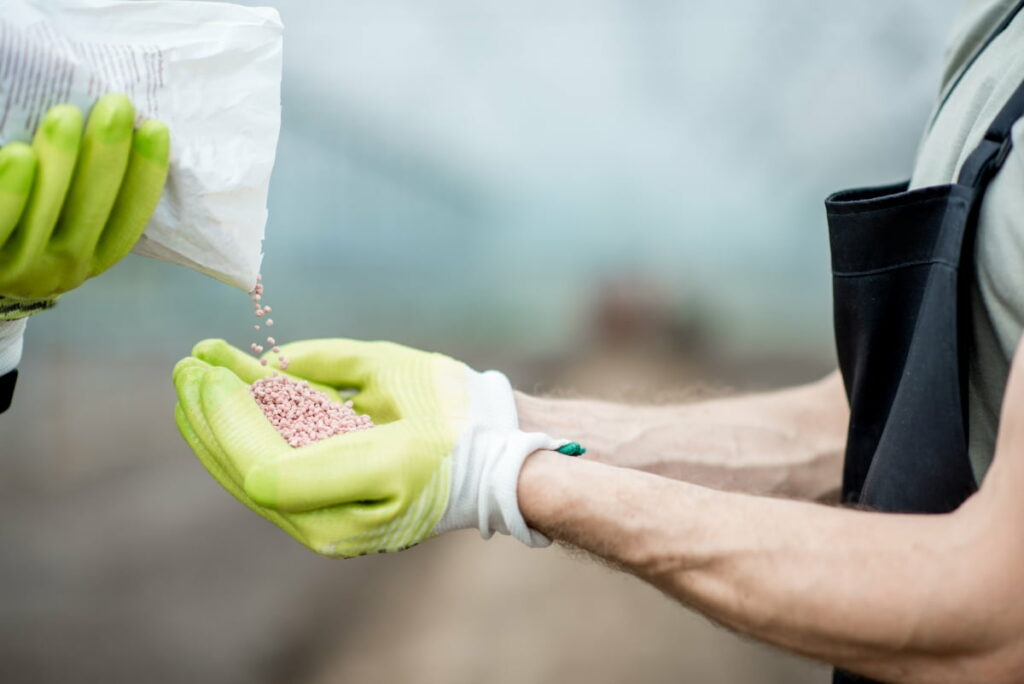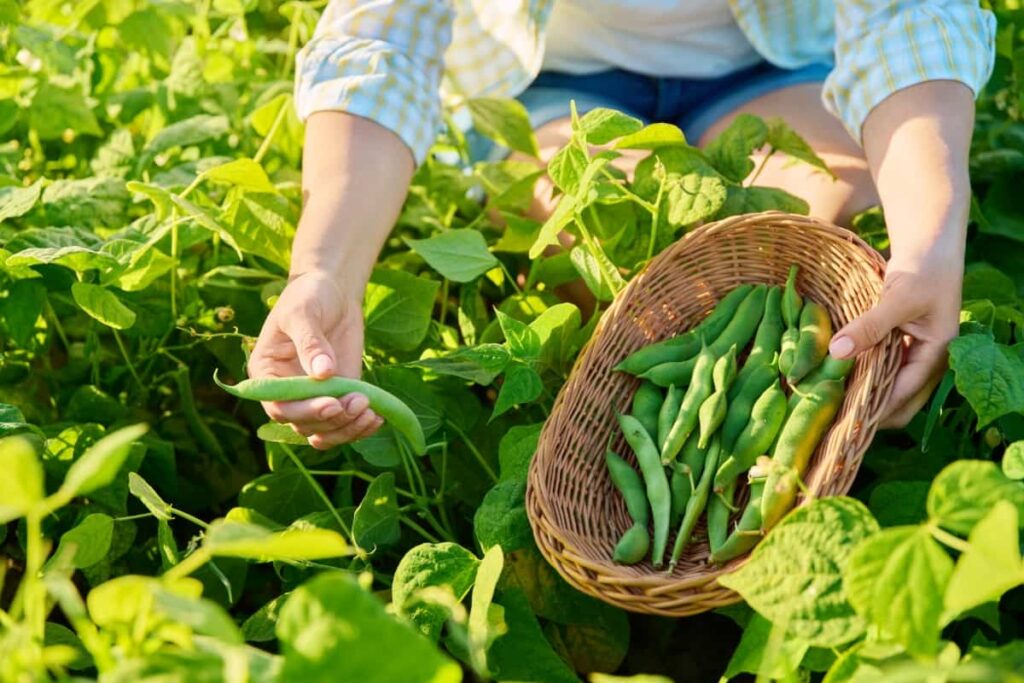Green beans are popular garden vegetables prized for their tender pods and nutritional value. To optimize their growth and yield, proper fertilization is essential. Green beans have specific nutritional needs, requiring adequate levels of nitrogen, phosphorus, potassium, and micronutrients for optimal growth and development.

Best Fertilizer for Green Beans
Importance of Soil Testing Before Fertilization
Before applying fertilizers, conducting soil tests is imperative. Soil testing helps determine the current nutrient levels, pH balance, and soil composition, allowing for tailored fertilization plans. This step ensures that green beans receive the right nutrients in the right amounts, minimizing waste and environmental impact while maximizing crop yield and quality.
Types of Fertilizers for Green Beans
Organic Fertilizers for Beans: Compost and Manure
Compost is a rich nutrient source and beneficial microorganisms. When applied to green beans, it enriches the soil with vital nutrients and promotes healthy growth and development. Organic manures, such as well-rotted animal manure when properly composted, manure releases nutrients slowly, providing a steady supply to green bean plants throughout their growth cycle. However, it’s essential to ensure that manure is fully composted to avoid the risk of burning plants.
Inorganic Fertilizers: NPK Ratios for Green Beans
Inorganic fertilizers are formulated with specific NPK ratios green beans, such as 10-10-10 or 5-10-5. These ratios can be adjusted depending on soil test results and plant needs. Nitrogen supports leafy growth, phosphorus aids in root development and flower production, and potassium enhances overall plant vigor and disease resistance in green beans.
Timing of Fertilization
Pre-Planting Soil Preparation
Before planting, assess soil nutrient levels through testing and amend accordingly. Incorporate organic matter like vermicompost or manure to improve soil structure and fertility.
Fertilizing at Planting Time
Before or during planting, apply fertilizers strategically to meet the initial nutrient demands of young plants. Balanced fertilizers with essential nutrients like nitrogen, phosphorus, and potassium promote early root development and overall vigor.
Side-Dressing Fertilizers for Green Beans
Side-dressing fertilizers for green beans with a balanced fertilizer, such as 10-10-10, when plants reach 4-6 inches in height and again when they start flowering. Apply fertilizer 2-4 inches away from the plant base, then water thoroughly. Avoid contact with foliage to prevent burning. Side-dressing ensures a continuous nutrient supply for healthy growth and robust yields in green bean plants.
Organic Fertilization Techniques
Benefits of Using Organic Matter
Incorporating organic matter into soil enhances its structure, water retention, and nutrient-holding capacity. Organic matter fosters a healthy soil microbiome, improves soil fertility, and reduces reliance on synthetic inputs.
Making and Using Compost Tea
Compost tea is easily crafted by steeping compost in water and aerating the mixture. Rich in beneficial microorganisms, enzymes, and nutrients, compost tea boosts soil health and plant vigor. Application through foliar spray or soil drench provides a direct nutrient boost and enhances disease resistance. Regular use of compost tea for green beans fosters robust growth, improves nutrient uptake, and promotes overall plant resilience.
Chemical Fertilization Strategies
Understanding Slow-Release vs. Quick-Release Fertilizers
- Slow-Release Fertilizers for Beans: Gradual nutrient release over time, reducing leaching and runoff.
- Quick-release Fertilizers for Beans: Rapid nutrient availability for immediate plant uptake.
Safety Measures and Application Tips
- Wear protective gear during handling.
- Avoid over-application to prevent environmental damage.
- Store fertilizers securely away from children as well as pets.
- Properly dispose of excess or unused fertilizers according to local regulations.
In case you missed it: Onion Growth Fertilizer Plan: Fertilization Schedule

The Role of Nitrogen in Green Bean Growth
Signs of Nitrogen Deficiency
Nitrogen is vital for green bean growth, essential in forming proteins and chlorophyll, pivotal for photosynthesis, and crucial for overall plant development. Symptoms of nitrogen deficiency in green beans include stunted growth, yellowing of older leaves, reduced pod formation, and overall poor plant vigor.
How to Correctly Apply Nitrogen Fertilizers
Apply nitrogen fertilizers evenly, avoiding excessive amounts, to prevent leaching and environmental damage. Consider soil tests to determine appropriate application rates and opt for slow-release fertilizers for sustained nutrient availability. Incorporate organic matter and use nitrogen-fixing legumes in crop rotation for natural enrichment.
Phosphorus and Potassium: The Other Essential Nutrients
Importance of Phosphorus for Root Development
Phosphorus plays a crucial role in fostering robust root systems, essential for green bean growth. Phosphorus in bean growth aids in energy transfer and supports the development of strong roots, enabling efficient nutrient uptake and water absorption.
Potassium for Disease Resistance and Pod Quality
Potassium is instrumental in bolstering green bean plants’ resistance to diseases while improving the quality of pods. Potassium for green beans regulates water uptake, enhances photosynthesis, and promotes disease resistance, resulting in healthier plants and higher-quality bean pods.
Micronutrients and Their Effects on Green Beans
Identifying and Correcting Micronutrient Deficiencies
Observing leaf discoloration or stunted growth can signal deficiencies. For instance, yellowing may indicate nitrogen or iron deficiency, while purpling suggests phosphorus deficiency. Applying balanced fertilizers or specific micronutrient supplements can rectify these issues.
Natural Sources of Micronutrients for Green Beans
Composting with organic matter enriches soil with micronutrients like iron, manganese, and zinc. Additionally, crop rotation helps replenish depleted nutrients naturally. Legumes, such as alfalfa or clover, fix nitrogen in the soil, benefiting subsequent green bean crops.
Watering and Fertilizer Application
The Relationship Between Irrigation and Fertilizer Efficiency
- Ensure watering at critical stages such as germination, flowering, and pod development to support healthy growth.
- Apply fertilizers rich in nitrogen, phosphorus, and potassium based on soil testing and crop requirements.
- Maintain a balance between irrigation and fertilizer application to maximize nutrient uptake and minimize nutrient leaching.
Best Practices for Watering Fertilized Green Beans
- Monitor soil moisture regularly and adjust watering accordingly.
- Apply fertilizers in accordance with soil test recommendations to avoid nutrient imbalances.
- Incorporate organic matter to improve water retention and nutrient availability.
- Use drip irrigation systems to deliver water and nutrients to the root zone directly, reducing wastage and increasing efficiency.
In case you missed it: Watermelon Fertilizer Management: Application Schedule and Methods

Monitoring and Adjusting Fertilization Practices
Regular Soil and Plant Tissue Testing
Implementing routine soil and plant tissue testing is essential for maintaining optimal fertilization practices. Soil testing for beans assesses nutrient levels, pH (6.0 to 6.5), and other crucial factors, providing insights into soil health. Similarly, plant tissue analysis evaluates nutrient uptake and identifies any deficiencies or excesses.
Adjusting Fertilization Based on Growth Stage and Plant Health
Adapting fertilization strategies according to growth stages and plant health ensures efficient nutrient utilization and prevents over-fertilization. During different growth phases, plants have varying nutrient requirements. Adjustments based on these stages optimize nutrient delivery, promoting healthy growth and development. Monitoring plant health indicators such as leaf color, size, and overall vigor helps tailor fertilization regimes to meet specific plant needs, enhancing productivity and minimizing environmental impacts.
In case you missed it: Best Fertilizer for Squash: What, When, and How to Apply

Conclusion
Selecting the best fertilizer for green beans involves a thoughtful consideration of the plant’s nutrient needs, soil conditions, and environmental impact. By choosing a balanced fertilizer, conducting soil tests, and incorporating organic options, gardeners can optimize yield while promoting sustainable gardening practices.p
- Profitable Village Farming Business Ideas in 2024
- High-Yield Aquaculture: Fast-Growing Fish for Farming
- Effective Fish Pond Construction Techniques for Beginners
- Irrigation and Water Management in Pineapple Farming
- Blossom to Harvest: Mastering Flowering and Pollination in Papaya Farming
- Pig Fattening Essentials: From Selection to Sale for Beginners
- Raising Wagyu Cattle: A Complete Guide for Premium Beef Production
- Soil Types and Their Water Holding Capacity
- Optimizing Irrigation Schedules for Coconut Groves for Enhanced Yield
